Appropriate lighting is important infrastructure to support walking. Lighting of the pedestrian network enables people walking to perceive hazards and find their way. Lighting also helps to mitigate the heightened risk from traffic particularly at crossings and greater risk to personal security during hours of darkness.
Pedestrian planning needs to consider the effect of lighting on illuminating a route, creating a feeling of safety for people walking and contributing to road safety. Illumination expands the number of hours people can walk, making the pedestrian network available beyond solely daylight hours. This is particularly relevant for people walking in winter-time where commute times are in hours of darkness and in public spaces that may be used at night.
The role of lighting for pedestrians is different to the role of lighting for motor vehicle drivers. Unlike motorised vehicles, most pedestrians do not walk with lights at night. Therefore, pedestrians need ambient or public lighting to see where they are going in safety and comfort. Lighting standards ensure that enough light is provided to make walking safe. However New Zealand research has been conducted to determine lighting that will encourage people to walk[3]. The research found that pedestrian lighting can influence perceptions of personal security for pedestrians. The research also found that lighting can be used to create, communicate or contribute to an area’s atmosphere and can help make walking a more positive experience and therefore a more appealing activity.
This section provides guidance on how best to provide adequate night-time illumination of the pedestrian network. It should also be read in conjunction with the relevant parts of M30 Specification and Guidelines for Road Lighting Design and NZS 1158 standards for road and public space lighting. Local authorities may also have their own guidance on pedestrian lighting, eg the Auckland Transport Design Manual.
Waka Kotahi M30 Specification and Guidelines for Road Lighting Design
AS/NZS1158 standards: Lighting for roads and public spaces(external link)
Auckland Transport Design Manual Engineering Design Code(external link)
Guidance on lighting design for cycle facilities is also applicable to pedestrian paths, especially if they are located away from the road corridor.
Cycling Network Guidance: Lighting
Lighting has several purposes for pedestrians, as well as co-benefits for other path users:
The need for lighting of the pedestrian route should be specifically assessed with consideration of:
Visiting sites during the hours of darkness is imperative as these visits help to establish the pedestrian environment. The number of people walking, lighting from other sources (such as shops or illuminated advertising), vehicle speeds, areas of risk, interactions with other path users, and vegetation that may cast shadows are all important components to observe. Creating a feeling of safety for people walking requires assessing the levels of lighting, the extent of passive surveillance along a route, and sight lines. The level of passive surveillance depends on the activity along a route, such as the presence of people and vehicles, active frontages and residential properties overlooking the route (‘eyes on the street’).
Often existing street lights are not adequate to illuminate the footpath through zone. Lighting audits should be undertaken to establish if the existing street lighting is adequate for people walking.
There are some locations where lighting may not be necessary because the area is not intended for night-time use, for example, recreational trails in rural areas where use is expected during daylight hours only.[1][3]
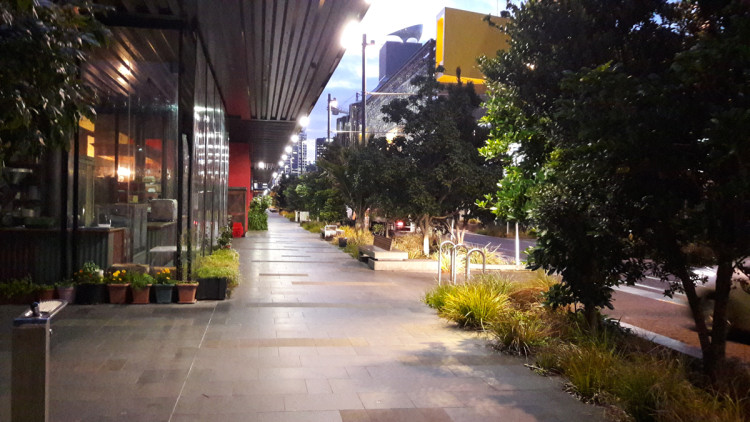
Lighting on path side of street furniture and landscaping zone, Wynyard Quarter, Auckland. (Photo: Jeanette Ward)
A pedestrian route that is well lit is one where the path and surroundings and other users are always visible. Generally, the overall lighting level and absence of glare are important for pedestrians. This means:
|
Design element |
Description |
|
Shadows and uniformity |
The significance of shadows, or apparent three-dimensionality, within a pedestrian lighting environment needs to be considered. The extent of shadows and lighting uniformity can be managed through the angle of light incidence, the intensity and number of light sources[3] |
|
Specific path lighting |
Where the pedestrian or shared use path is separated from the main road carriageway, it may need its own lighting. The lighting designer must ensure that enough light consistently reaches the surface and people using the facility. |
|
Lighting placement |
Where footpaths are within road reserves, placing lights along both sides of the road is better for pedestrians than putting them within the roadway median. |
|
Vertical illuminance |
Visibility to other approaching path users is necessary and hence the need to ensure that the lighting design achieves the required level of vertical surface illumination (ie light landing on the side of an object). |
|
Horizontal illuminance |
The visibility of a pedestrian path is not solely based on the quantity of light cast onto the surface. The quantity of light reflected by the ground surface (‘horizontal illuminance’) is also important. |
|
Minimising light spill |
All lamps and luminaires should be designed to ensure light is directed downwards, to reduce unwanted light spill, improve energy efficiency and minimise light pollution into the night sky. There are competing demands of facilities allowing people to see/be seen whilst also being able to see the natural environment. It is important that the lighting does not create a nuisance to adjacent users or neighbouring properties (for example, through unwanted spill light). This can be avoided with directed lighting and lighting shields. In pedestrian precincts where there is no risk of glare to motorised traffic light can be emitted horizontally. |
|
Crime Prevention |
The principles of 'Crime Prevention through Environmental Design(external link)' (CPTED) must be considered, particularly in terms of shadows, sight lines, placement of shrubs and overall brightness of a route.The visibility field for physical safety is approximately 10 metres[3]. |
|
Conflict points |
A higher level of well-directed lighting is likely necessary at locations where potential conflicts or hazards are present, including road crossings, uneven surfaces, underpasses and around objects such as bollards and barriers. |
|
Redundancy |
There should be an element of ‘redundancy’, so that if one lamp fails, another will continue to provide at least some light in the affected area, eg by using LED arrays. |
|
LED versus HPS lamps |
LED bulbs are recommended due to energy efficiency, longer lifetime and better light quality when compared with High Pressure Sodium (HPS) bulbs[4]. |
|
Lighting colour |
Trials for Waka Kotahi support the idea that visibility is improved by the wider spectrum achieved from ‘white’ light sources like LEDs[4]. Additionally, amber or warm light sources should be selected over those with higher blue emissions[5]. |
|
Smart devices |
Increasingly, new road or path lighting installations allow for additional ‘smart’ devices to also be added to the same luminaire head, including cameras, counters, wi-fi hotspots and environmental sensors. These might provide for improved data collection or user amenity. |
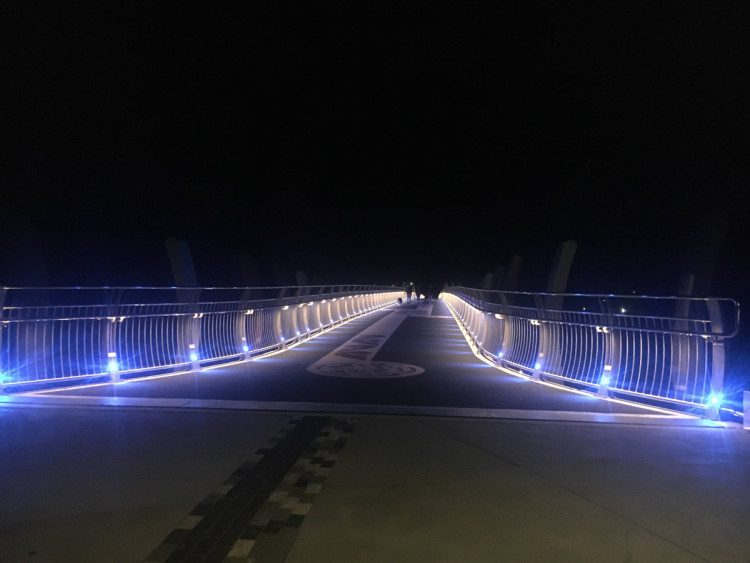
He Ara Kotahi bridge (Manawatu River) lighting at night, Palmerston North. (Photo: James Wratt)
Lighting in grade-separated crossings, particularly underpasses, requires specific attention to pedestrian and cyclist safety concerns. It should appear bright while avoiding glare and shadows, which can be done by carefully selecting textures and colours. Transitions at connecting elements (entering or exiting an underpass) will require a specific design to accommodate the user adjusting to the change in lighting levels. The lighting on the approaches should match the lighting in the underpass itself. Lighting designers should consider multiple levels of lighting, providing daytime underpass lighting levels as well as night-time underpass lighting levels. In daylight, the issue is the change when moving from bright sun into a tunnel with low lighting, or out of a tunnel with low lighting. Drastic changes in lighting levels can dazzle as eyes take time to adjust to the change.
Lighting should operate continuously in many underpasses – with consideration for CPTED. Daylight can be maximised in underpasses beneath divided carriageways, with two shorter tunnels under each direction of traffic, rather than under the full carriageway, separated by daylighting gaps. These act as midway skylights, providing natural lighting halfway. At other locations, lighting tubes can also be used to direct daylight down to an underpass.
Avoid using widely spaced recessed lamps that create pools of light in amongst dark areas. As underpass lamps will be at a relatively low level, they should be made of polycarbonate or be otherwise resistant to vandalism. Consider installing an emergency lighting system to ensure illumination if the main power supply fails.
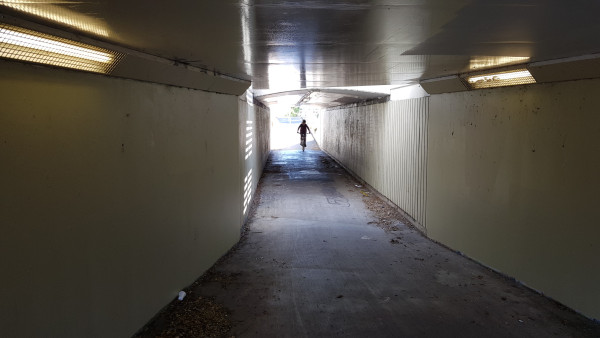
Skylight between the two directions of motorway traffic, Annex Road underpass Christchurch. (Photo: Glen Koorey)

Aerial image of the underpass location. (Source: Canterbury Maps)
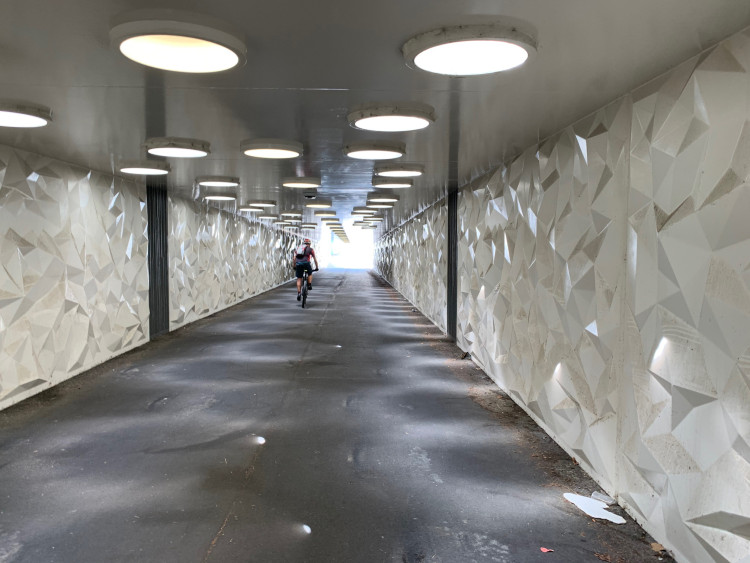
Angled light tubes from the roundabout above used to illuminate the underpass, supported by LED lights down the centre of the tunnel, Harewood Road, Christchurch. (Photo: John Lieswyn)
The type of lighting depends on the type of pedestrian facility. Crossings require greater levels of lighting than low-use residential streets (where regular street lighting may suffice). There are a wide variety of types of lighting, such as normal overhead lamps, in wall lighting, handrail lighting and lighting for temporary projects. Lighting for cycling on shared paths can have co-benefits for pedestrians. The Cycling Network Guidance outlines specific lighting guidelines for cycling infrastructure.
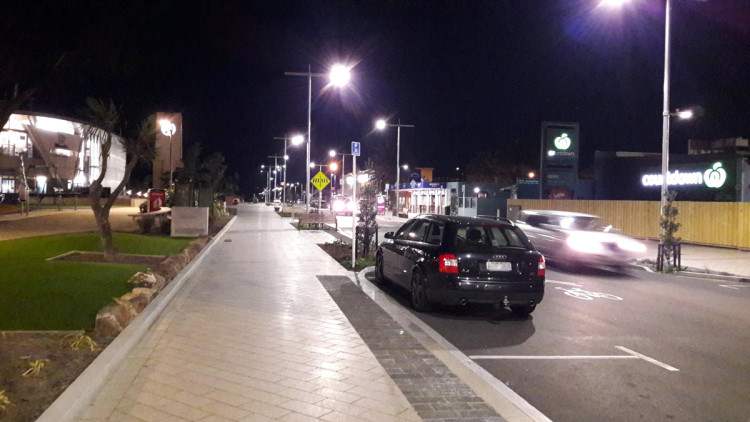
Street lighting illuminating the footpath, Marine Parade, Christchurch. (Photo: Jeanette Ward)
These can have different properties:
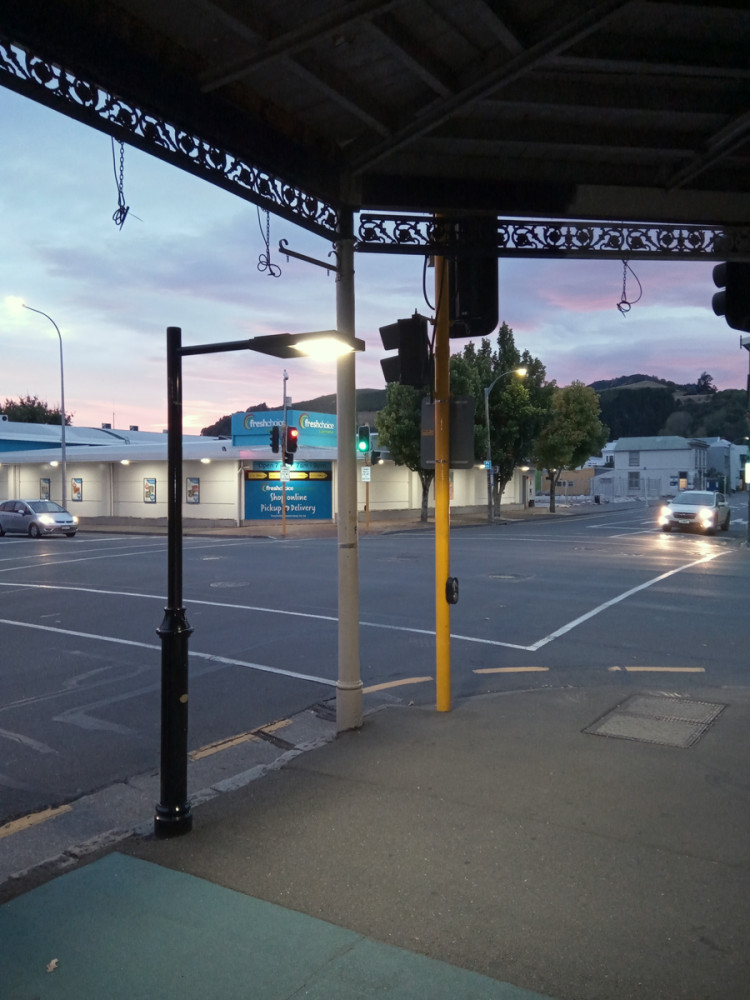
Overhead lighting illuminates the pedestrian waiting area under a verandah, Bridge St / Collingwood Street, Nelson. (Photo: Mark Edwards)
Sometimes used as low mounted lights in a wall. Te Ara a Whiti (the Auckland Light path) and He Ara Kotahi Bridge (in Palmerston North) are great examples of in-wall lighting.
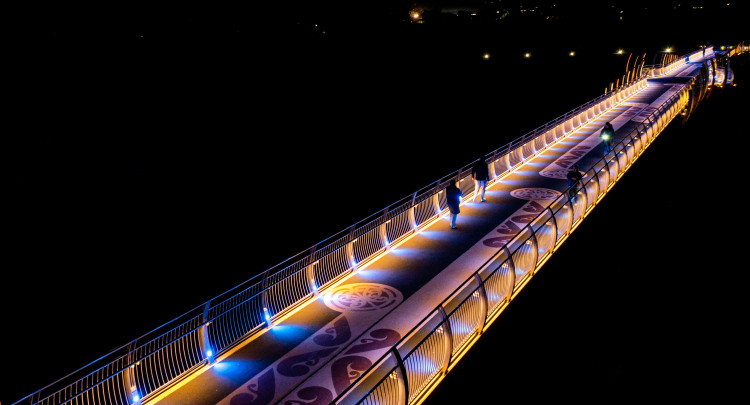
In-wall and handrail lighting used to illuminate the bridge design of a fallen karaka tree, He Ara Kotahi Bridge. (Source: Palmerston North City Council)
Handrail lighting is often used to illuminate ramps, or bridges. It can be difficult to meet vertical plane illumination sufficient for face recognition, and hence Crime Prevention Through Environmental Design comfort (CPTED). Because people’s faces are not directly illuminated, there is a reliance on reflection from surfaces. Light coloured pavements may assist but, if too bright, glare can occur.

Handrail lighting, Te Rāranga bridge, Central Christchurch. (Photo: Nick Reid)
These can be used to highlight a wall, cycle parking or other objects. Lighting can be placed overhead, on the ground or on walls. The object may be a tree/sculpture/feature or an object/hazard that path users need to avoid.
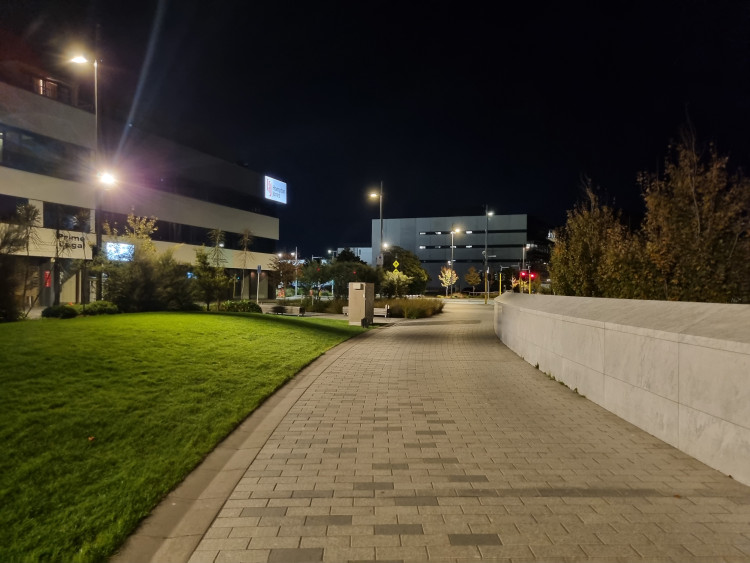
Overhead light directed at concrete wall to illuminate the wall, Oxford Terrace, Christchurch. (Photo: Nick Reid)
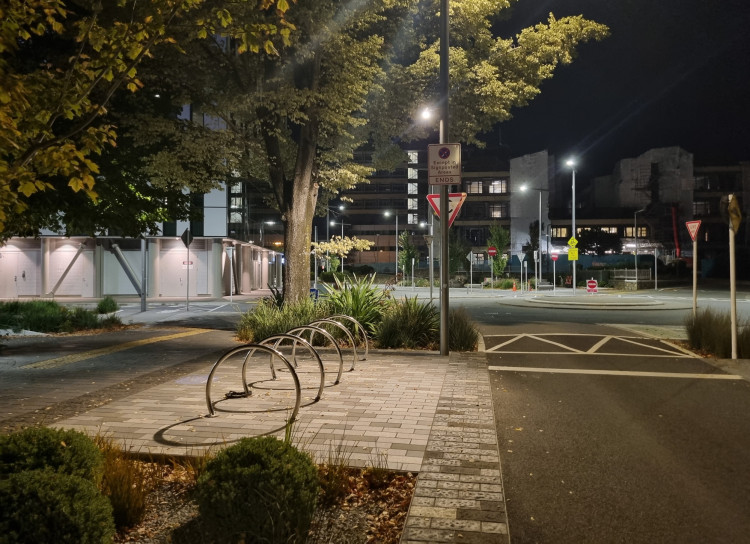
Overhead lighting used to illuminate bike parking, Oxford Terrace, Christchurch. (Photo: Nick Reid)
Temporary lighting is used to light intersections, pedestrian crossings and courtesy crossings mainly in adaptive urbanism projects, where changes to the street can be tested and better understood by people before final implementation of any changes to a street.
Refer to The Selection and Use of Non-Permanent Materials for Pilot Projects [PDF, 2 MB] section 3.5 Temporary Lighting.

Temporary lights (left to right - overhead pole, concrete base mount (Auckland), cage mount. (Source: Tauranga City Council)
Additionally, there are other light sources such as in-ground stud lighting and luminescent path granules, but these do not substitute for lighting that illuminates people or paths. Instead, they are a form of delineation. Refer to CNG for further information.
Cycling Network Guidance: Lighting
The following indicative table suggests appropriate locations for the different lighting options discussed above. The most suitable lighting types for a location are marked by a tick (checkmark) symbol, and lighting types only suitable as a secondary lighting source are marked with a diamond symbol. A secondary lighting source should always be placed in combination with one of the primary lighting sources.

Appropriate locations for different types of lighting. View larger image [JPG, 57 KB].
Design of lighting is a specialised technical discipline. The standards and specifications cover the average and minimum levels of illumination in the horizontal plane to illuminate the path surface and in the vertical plane to illuminate faces. The standards also control glare to path users and light spill to adjacent areas and upwards to preserve dark skies. The reflective properties of a ground surface is also a lighting issue; reflection can be improved with a light-coloured surface - but caution should be taken to ensure that glare is not an issue under bright sunshine.
AS/NZS 1158.3.1: 2020 is the standard for lighting in pedestrian areas or routes and it applies to pedestrian-only areas as well as those with a mix of pedestrians, motor vehicles and cyclists. The standard also covers the lighting required at pedestrian islands and traffic-calming measures.
AS/NZS 1158.3.1:2020 Pedestrian area lighting(external link)
The table below shows the criteria for various lighting subcategories for:
Table 1 Lighting PP sub-categories for pedestrian routes (from Tables 2.1-2.3 of AS/NZS 1158.3.1.) with potential locations where the lighting could be used.
| Selection criteria | |||
|
Pedestrian |
Fear of crime |
Lighting subcategories |
Potential appropriate location for use |
|
N/A |
High |
PP1 / PR1 / PA1 |
Route/area with a known high crime risk |
|
High |
Medium |
PP2 / PR2 / PA2 |
Major cycle route with low passive surveillance |
|
Medium |
Low |
PP4 / PR4 / PA3 |
|
|
Low |
Low |
PP5 / PR5 / PA3 |
Street with good passive surveillance, low cycle volumes |
For connecting elements, such as underpasses and bridges, the following (PE) sub-categories are generally appropriate:
Pedestrian crossing points need more intense lighting than paths to ensure that users are clearly visible to other path users and that approaching drivers can clearly see people crossing. Lighting must comply with:
Generally, the relative ‘busyness’ of the road (in terms of road hierarchy, traffic speed and traffic volumes) will determine whether a PX1, PX2 or PX3 lighting category is appropriate. Meanwhile, categories X1 and X2 are used for pedestrian (zebra) crossings (including dual crossings), with crossing user volumes generally being the differentiating criterion.
Cycling Network Guidance: Dual crossings
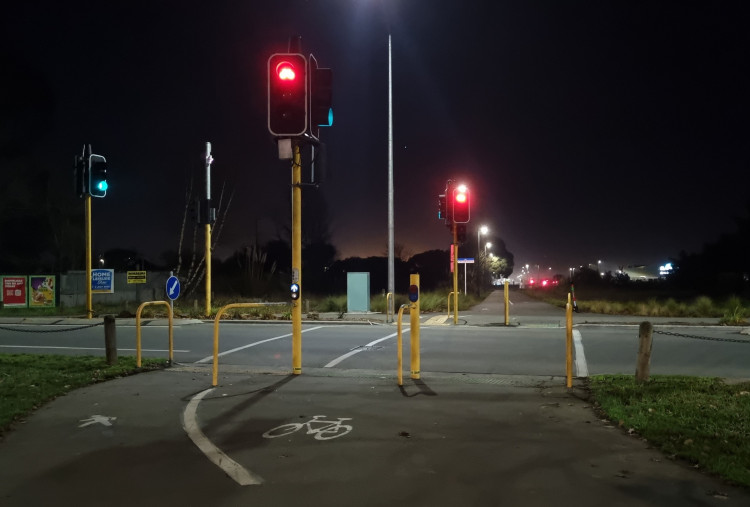
Adequate overhead lighting of the signalised pedestrian/cycle crossing, Deans Avenue. Christchurch. (Photo: Nick Reid)
The M30 Specification and Guidelines for Road Lighting Design (Waka Kotahi, 2014) is relevant to roads, cycleways, footpaths, tunnels, underpasses, overpasses and bridges on State Highways, but can also be adopted for use by other Road Controlling Authorities. The document has some guidelines on specific illuminance levels for pedestrian paths, cycleways, underpasses and overpasses. Design spacing of lamps on walkways and cycleways are also given.
M30 Specification and Guidelines for Road Lighting Design (Waka Kotahi, 2014)
Local authorities may also have their own guidance on pedestrian lighting, eg Auckland Transport’s Street Lighting engineering design code.
[1] Ministry of Justice, 2005. National Guidelines for Crime Prevention through Environmental Design in New Zealand, part 1: Seven qualities of safer places
[2] NZ Transport Agency. (2013). Bridging the gap: NZTA urban design guidelines.
[3] Lester, T 2010. Public lighting for safe and attractive pedestrian areas. NZ Transport Agency research report 405.
[4] WSP Opus Research. (2019). The safety, health and environmental implications of adopting LED over High Pressure Sodium road lighting [PDF, 2 MB].
[5] Royal Society of NZ. (Undated). Blue light Aotearoa, Impacts of artificial blue light on health and the environment, evidence summary(external link).